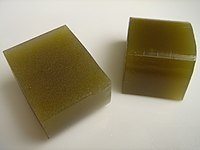
Photo from wikipedia
Berries are among the nutritionally richest fruits and the mixing of these fruits can originate products with peculiar characteristics and added value, since the fruit mixture allows adding nutritional and… Click to show full abstract
Berries are among the nutritionally richest fruits and the mixing of these fruits can originate products with peculiar characteristics and added value, since the fruit mixture allows adding nutritional and sensory value to the final product. Thus, in this study we aimed to optimize a mixed berry jelly formulation of red fruit (blackberry, blueberry, and strawberry), through the mixture design, desirability function, and response surface methodology. The fruit mixture influenced the physical-chemical, sensory, and nutritional characteristics of mixed jelly, and it was observed that the mixture of two or more fruits may increase the acceptance of the product and even its nutritional value. According to the contour curve graph for the sensory and nutritional desirability function, the ideal mixed berry jelly should contain 55% to 100% blackberry, 0% to 20% blueberry, and 0% to 40% strawberry. The exact proportion of fruit may depend on seasonality or the commercial value of the fruit. PRACTICAL APPLICATION: In Brazil, there are many blackberry, blueberry, and strawberry cultivars grown in subtropical regions and high perishability hinders the fruit consumption in fresh form. In this context, through this study it was possible to verify which fruits are more suitable for processing in the form of jelly, as well as to optimize, based on sensory and nutritional characteristics, a mixed berry jelly formulation with greater attractiveness to consumers.
Journal Title: Journal of food science
Year Published: 2019
Link to full text (if available)
Share on Social Media: Sign Up to like & get
recommendations!